Investigating Potential Toxicity of Leachate from Wood Chip Piles Generated by Roadside Biomass Operations
Abstract
:1. Introduction
2. Experimental Section
2.1. Collection of Wood Chip Samples
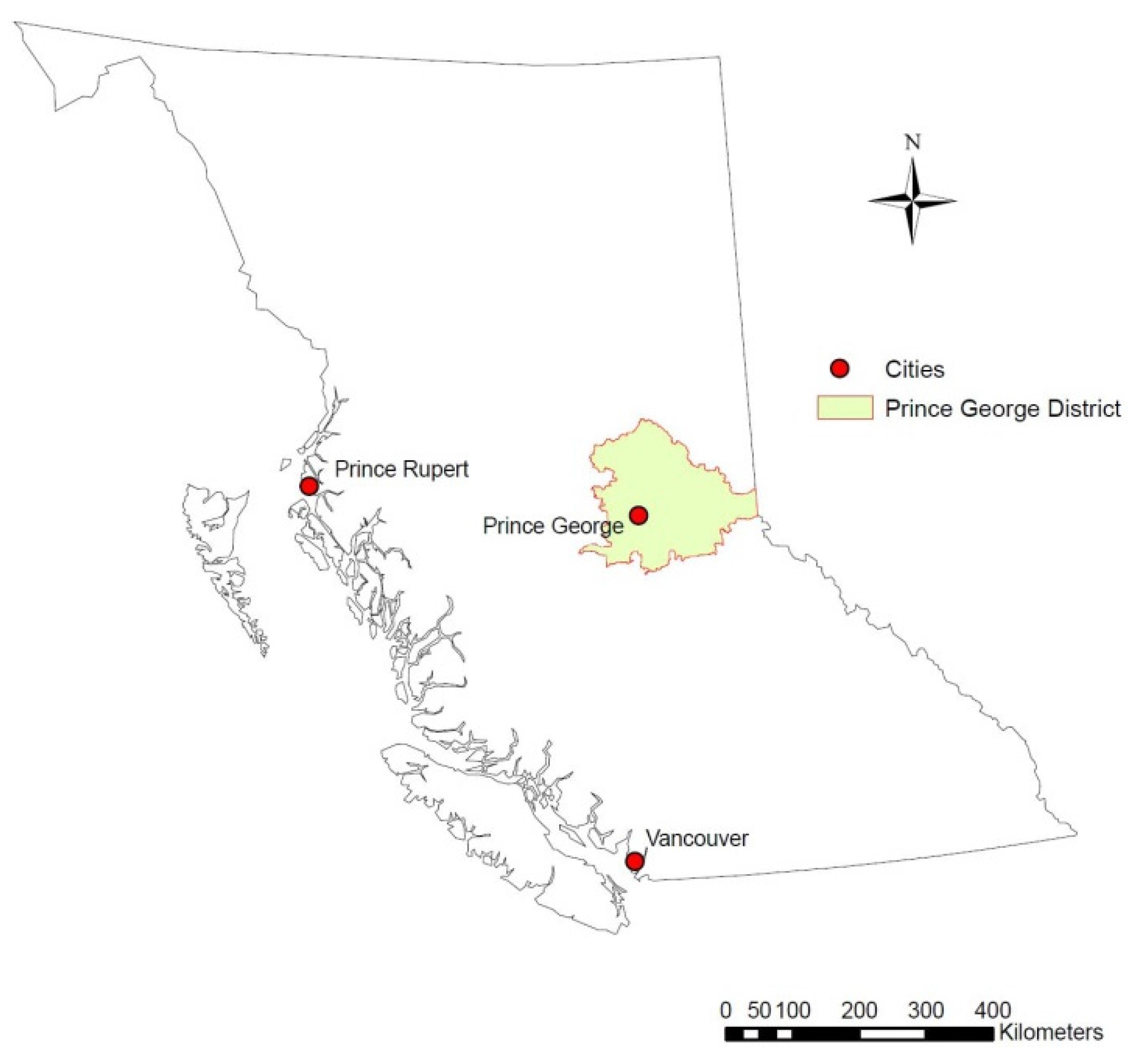
2.2. Leaching Fluids and Leachate Generation
2.3. Chemical and Toxicity Analysis
| Parameter | Analytical Technique | Detection Limit |
|---|---|---|
| pH | Electrometric Method (SM-4500H+B) | |
| True Color | Visual Comparison Method (SM-2120B) | 100 Color units |
| Total Organic Carbon | Persulfate-Ultraviolet or Heated-Persulfate Oxidation Method (SM 5310 C) | 5.0 mg·L−1 |
| Chemical Oxygen Demand | Closed Reflux, Colorimeter (SM-5220D) | 20 mg·L−1 |
| Ammonium | Automated Phenate Method (SM-4500NH3G) | 0.005 mg·L−1 |
| Resin Acids | Extraction and Gas Chromatography (STL SOP-00152) | |
| Phenols | Direct Photometric Method (SM 5530) | 0.01 mg·L−1 |
| Microtox | Biological Test Method: Toxicity Test Luminescent Bacteria, 1/RM/24: Environment Canada |
3. Results and Discussion
3.1. Operational Samples
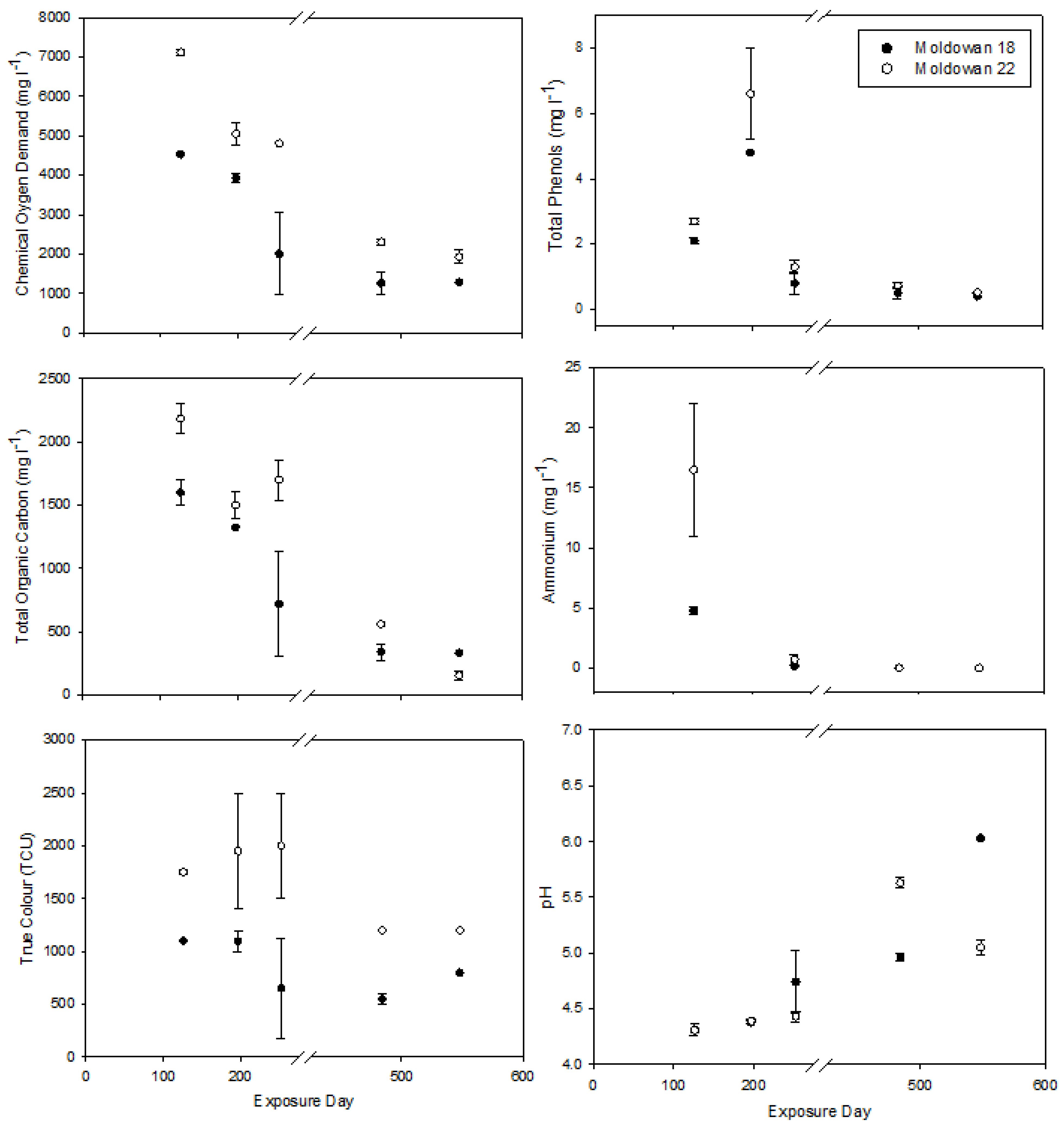
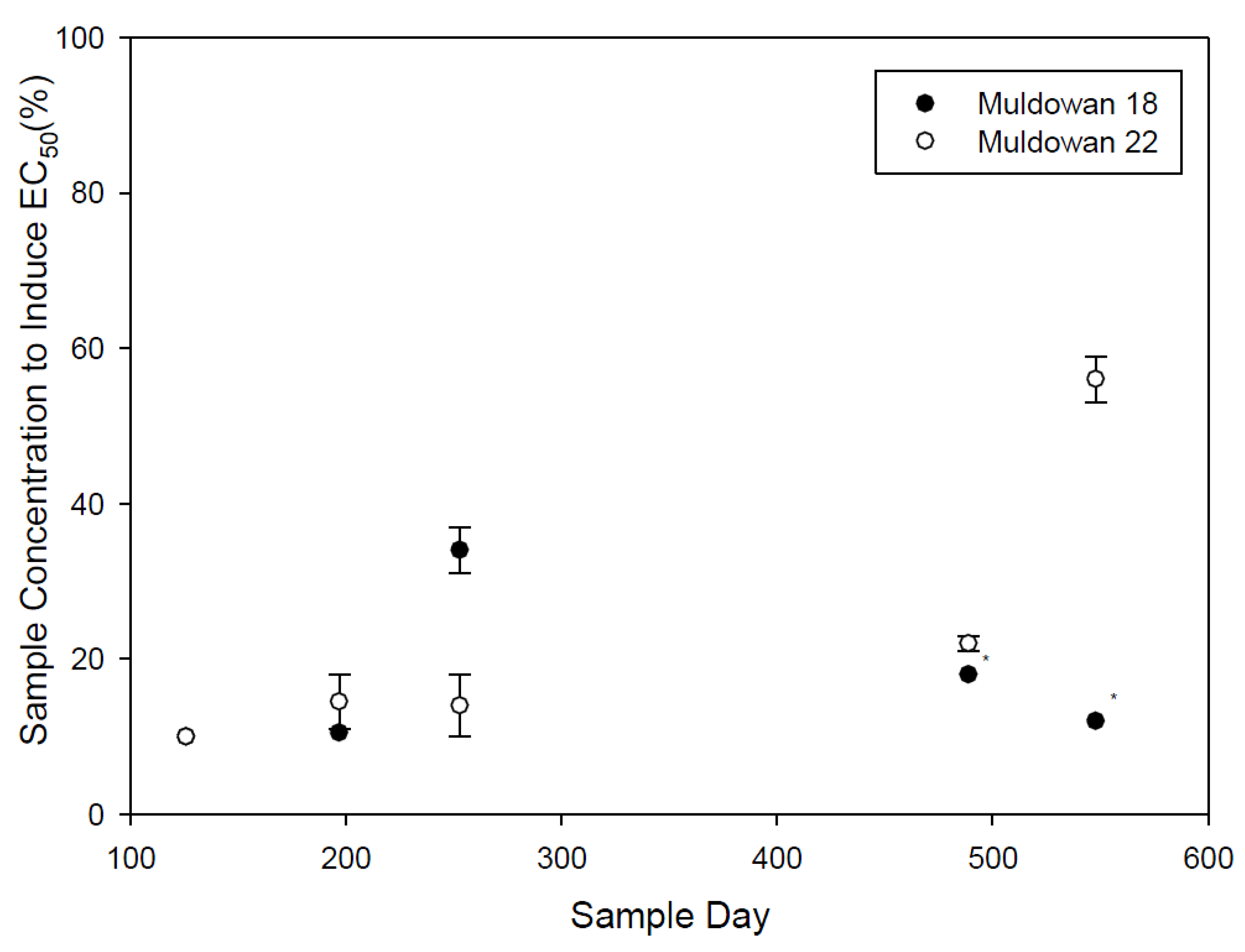
3.2. Static Samples
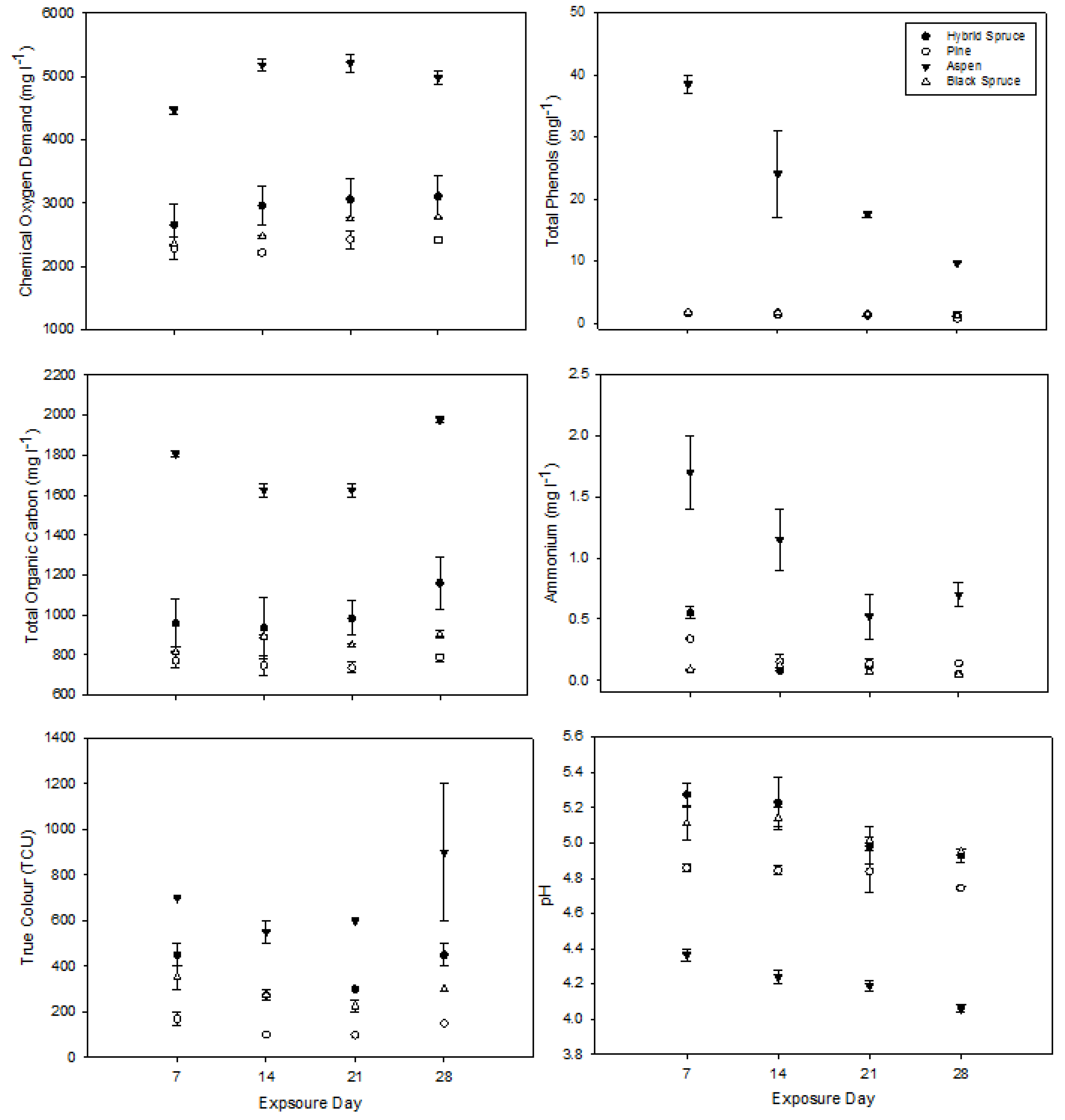
| Parameter | Kruskal-Wallis Test and p-Value | Sum of Ranks |
|---|---|---|
| Total Organic Carbon | K − W = 25.98, p = 0 | Aspen > Black Spruce > Hybrid Spruce > Pine |
| Chemical Oxygen Demand | K − W = 23.01, p = 0 | Aspen > Hybrid Spruce > Black Spruce > Pine |
| True Color | K − W = 27.07, p = 0 | Aspen > Hybrid Spruce > Black Spruce > Pine |
| Phenol | K − W = 25.24, p = 0 | Aspen > Black Spruce > Pine > Hybrid Spruce |
| Ammonia | K − W = 19.3, p = 0 | Aspen > Hybrid Spruce > Black Spruce > Pine |
| pH | K − W = 23.01, p = 0 | Hybrid Spruce > Black Spruce > Pine > Aspen |
3.3. Rainfall Simulations
| Sample | Condition | Starting Moisture (%) * | Moisture Gained (%) |
|---|---|---|---|
| Moldowan 18 | Dry | 0.0 | 28.0 |
| Moldowan 18 | Saturated | 36.6 (5.4) | −1.3 |
| Moldowan 22 | Dry | 0.0 | 19.8 |
| Moldowan 22 | Saturated | 37.1 (1.9) | 0.1 |
| Pine | Dry | 0.0 | 27.2 |
| Pine | Saturated | 34.2 (3.7) | −2.4 |
| Hybrid Spruce | Dry | 0.0 | 20.5 |
| Hybrid Spruce | Saturated | 34.2 (0.7) | −2.9 |
| Black Spruce | Dry | 0 | 22.3 |
| Black Spruce | Saturated | 33.3 (2.6) | −1.0 |
| Aspen | Dry | 0.0 | 19.2 |
| Aspen | Saturated | 30.4 (1.5) | 5.3 |
| Parameter | Mann-Whitney U test and p-Value |
|---|---|
| Total Organic Carbon | Mann-Whitney U = 0, p =0 |
| Chemical Oxygen Demand | Mann-Whitney U = 0, p = 0 |
| True Color | Mann-Whitney U = 0, p = 0 |
| Phenol | Mann-Whitney U = 41, p = 0.001 |
| Ammonia | Mann-Whitney U = 128, p = 1 |
| pH | Mann-Whitney U = 174, p =0 |


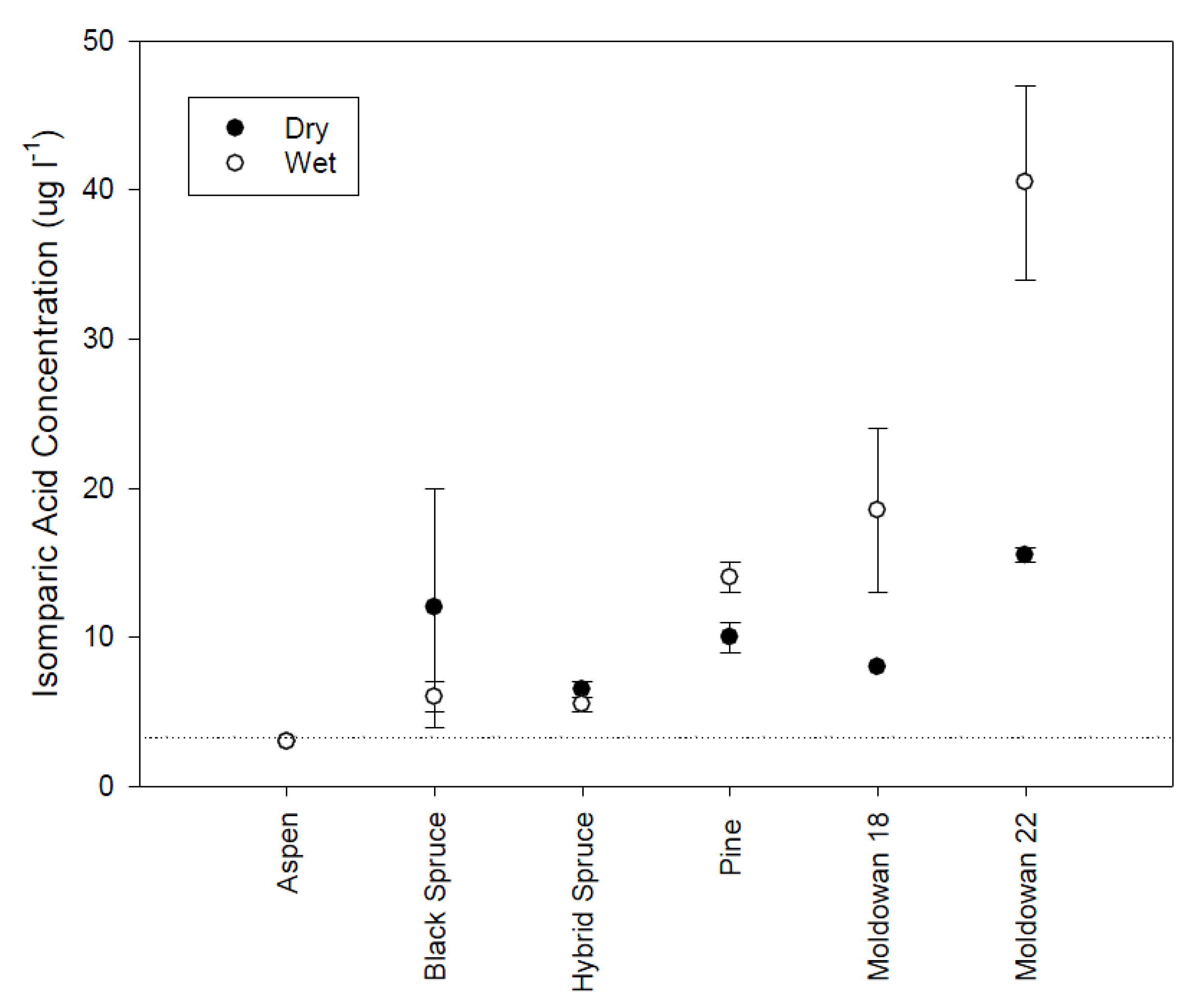
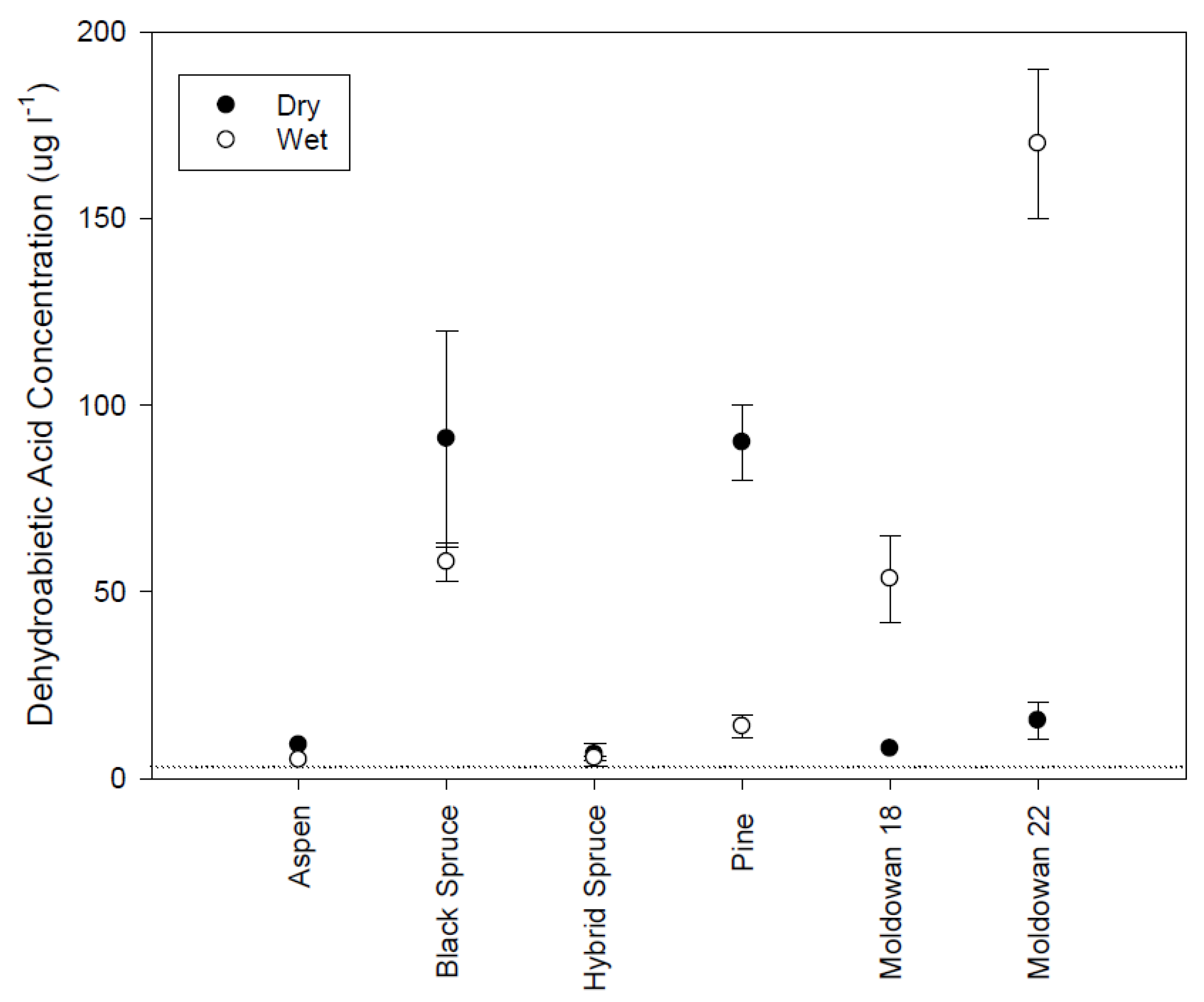
4. Conclusions
Acknowledgments
Author Contributions
Conflicts of Interest
References
- Food and Agricultural Organization of the United Nations. Forests and Energy: Key Issues; FAO Forestry Paper 154; FAO: Rome, Italy, 2008; p. 73. [Google Scholar]
- Janowik, M.K.; Webster, C.R. Promoting ecological sustainability in woody biomass harvesting. J. For. 2010, 108, 16–23. [Google Scholar]
- Stennes, B.K.; McBeath, A. Bioenergy Options of Woody Feedstock: Are Trees Killed by Mountain Pine Beetle in British Columbia a Viable Bioenergy Resource? Pacific Forestry Centre: Victoria, BC, Canada, 2006; p. 38. [Google Scholar]
- Orban, J.L.; Kozak, R.A.; Sidle, R.C.; Duff, S.J. Assessment of relative environmental risk from logyard run-off in British Columbia. For. Chron. 2002, 78, 146–151. [Google Scholar] [CrossRef]
- Hedmark, Å.; Scholz, M. Review of environmental effects and treatment of runoff from storage and handling of wood. Bioresour. Technol. 2008, 99, 5997–6009. [Google Scholar]
- Tao, W.; Hall, K.J.; Masbough, A.; Frankowski, K.; Duff, S.J. Characterization of leachate from a woodwaste pile. Water Qual. Res. J. Can. 2005, 40, 476–483. [Google Scholar]
- Taylor, B.R.; Carmichael, N.B. Toxicity and chemistry of aspen wood leachate to aquatic life: Field study. Environ. Toxicol. Chem. 2003, 22, 2048–2056. [Google Scholar] [CrossRef] [PubMed]
- Kabzems, R.; Dube, S.; Curran, M.; Chapman, B.; Berch, S.; Hope, G.; Kranabetter, M.; Bulmer, C. Maintaining Soil Productivity in Forest Biomass Chipping Operations Best Management Practices for Soil Conservation; Forest Science Program: Victoria, BC, Canada, 2011; p. 10. Available online: www.for.gov.bc.ca/hfd/pubs/Docs/En/En98.htm (accessed on 8 August 2015).
- Libralato, G.; Losso, C.; Ghirardini, A.V. Toxicity of untreated wood leachates towards two saltwater organisms (Crassostrea gigas and Artemia franciscana). J. Hazard. Mater. 2007, 144, 590–593. [Google Scholar] [CrossRef] [PubMed]
- Machrafi, Y.; Prévost, D.; Beauchamp, C.J. Toxicity of phenolic compounds extracted from bark residues of different ages. J. Chem. Ecol. 2006, 32, 2595–2615. [Google Scholar] [CrossRef] [PubMed]
- Wilson, A.E.; Moore, E.R.; Mohn, W.W. Isolation and characterization of isopimaric acid-degrading bacteria from a sequencing batch reactor. Appl. Environ. Microbiol. 1996, 62, 3146–3151. [Google Scholar] [PubMed]
- Peng, G.; Roberts, J.C. Solubility and toxicity of resin acids. Water Res. 2000, 34, 2779–2785. [Google Scholar] [CrossRef]
- Lahdelma, I.; Oikari, A. Resin acids and retene in sediments adjacent to pulp and paper industries. J. Soil. Sediment. 2005, 5, 74–81. [Google Scholar] [CrossRef]
- Liss, S.N.; Bicho, P.A.; Saddler, J.N. Microbiology and biodegradation of resin acids in pulp mill effluents: A minireview. Can. J. Microbiol. 1997, 43, 599–611. [Google Scholar] [CrossRef] [PubMed]
- Makris, S.P.; Banerjee, S. Fate of resin acids in pulp mill secondary treatment systems. Water Res. 2002, 36, 2878–2882. [Google Scholar] [CrossRef]
- Jenkins, B.M.; Bakker, R.R.; Wei, J.B. On the properties of washed straw. Biomass Bioenergy 1996, 10, 177–200. [Google Scholar] [CrossRef]
- Miles, T.R.; Miles, T.R., Jr.; Baxter, L.L.; Bryers, R.W.; Jenkins, B.M.; Oden, L. Boiler deposits from firing biomass fuels. Biomass Bioenergy 1996, 10, 125–138. [Google Scholar] [CrossRef]
- Khan, A.A.; de Jong, W.; Jansens, P.J.; Splietoff, H. Biomass combustion in fluidized bed boilers: Potential problems and remedies. Fuel Process. Technol. 2009, 90, 17–46. [Google Scholar] [CrossRef]
- Rajabzadeh, A.R.; Ruzich, N.; Zendehbouhdi, S.; Rahbari, M. Biomass leachate and nutrient recovery using reverse osmosis: Experimental study and hybrid artificial neural network modeling. Energy Fuels 2012, 26, 7155–7163. [Google Scholar] [CrossRef]
- Jenkins, B.M.; Baxter, L.L.; Miles, T.R., Jr.; Miles, T.R. Combustion properties of biomass. Fuel Process. Technol. 1998, 54, 17–46. [Google Scholar] [CrossRef]
- Vamvuka, D.; Zografors, D.; Alevizoz, G. Control methods for mitigating biomass ash-related problems in fluidized beds. Bioresour. Technol. 2008, 99, 3534–3544. [Google Scholar] [CrossRef] [PubMed]
- Steenari, B.M.; Lundberg, A.; Pettersson, H.; Wilewska-Bien, M.; Andersson, D. Investigation of ash sintering during combustion of agricultural residues and effect of additives. Energy Fuels 2009, 23, 5655–5662. [Google Scholar] [CrossRef]
- Taylor, B.R.; Goudey, J.S.; Carmichael, N.B. Toxicity of aspen wood leachate to aquatic life: Laboratory studies. Environ. Toxicol. Chem. 1996, 15, 150–159. [Google Scholar] [CrossRef]
- Clarke, M.A.; Walsh, R.P. A portable rainfall simulator for field assessment of splash and slopewash in remote locations. Earth Surf. Process. Landf. 2007, 32, 2052–2069. [Google Scholar] [CrossRef]
- Environment Canada. Biological Test Method: Toxicity Test Using Luminescent Bacteria; Report EPS 1/RM/24; Environment Canada: Ottawa, Canada, 1992; p. 75. [Google Scholar]
- Sokal, R.R.; Rohlf, F.J. The Principles and Practice of Statistics in Biological Research, 3rd ed.; W.H. Freeman & Co.: New York, NY, USA, 1994; p. 880. [Google Scholar]
- McLuaghan, P.G.; Almashqabeh, O. Effect of media type on dissolved organic carbon release from woody filtration media. Bioresource. Technol. 2009, 100, 1020–1023. [Google Scholar] [CrossRef] [PubMed]
- Muna, A.; Sreekrishnan, T.R. Aquatic toxicity from pulp and paper mill effluents: A review. Adv. Environ. Res. 2001, 5, 175–196. [Google Scholar]
- Thompson, G.; Swain, J.; Kay, M.; Forster, C.F. The treatment of pulp and paper mill effluent: A review. Bioresour. Technol. 2001, 77, 275–286. [Google Scholar] [CrossRef]
- Bernard, C.; Colin, J.R.; Anne, I.D.D. Estimation of the hazard of landfills through toxicity testing of leachates: 2. Comparison of phsico-chemical charactersitics of landfill leachates with the toxicity determined with a battery of tests. Chemosphere 1997, 35, 2783–2796. [Google Scholar] [CrossRef]
- Hao, O.J.; Shin, C.J.; Lin, C.F.; Jeng, F.T.; Chen, Z.C. Use of microtox tests for screening industrial wastewater toxicity. Water Sci. Technol. 1996, 34, 43–50. [Google Scholar] [CrossRef]
- Gutierrez, M.; Etxebarria, J.; de las Fuentes, L. Evaluation of wastewater toxicity: Comparative study between Microtox® and activated sludge oxygen uptake inhibition. Water Res. 2002, 36, 919–924. [Google Scholar] [CrossRef]
© 2016 by the authors; licensee MDPI, Basel, Switzerland. This article is an open access article distributed under the terms and conditions of the Creative Commons by Attribution (CC-BY) license (http://creativecommons.org/licenses/by/4.0/).
Share and Cite
Rex, J.; Dubé, S.; Krauskopf, P.; Berch, S. Investigating Potential Toxicity of Leachate from Wood Chip Piles Generated by Roadside Biomass Operations. Forests 2016, 7, 40. https://doi.org/10.3390/f7020040
Rex J, Dubé S, Krauskopf P, Berch S. Investigating Potential Toxicity of Leachate from Wood Chip Piles Generated by Roadside Biomass Operations. Forests. 2016; 7(2):40. https://doi.org/10.3390/f7020040
Chicago/Turabian StyleRex, John, Stephane Dubé, Phillip Krauskopf, and Shannon Berch. 2016. "Investigating Potential Toxicity of Leachate from Wood Chip Piles Generated by Roadside Biomass Operations" Forests 7, no. 2: 40. https://doi.org/10.3390/f7020040
APA StyleRex, J., Dubé, S., Krauskopf, P., & Berch, S. (2016). Investigating Potential Toxicity of Leachate from Wood Chip Piles Generated by Roadside Biomass Operations. Forests, 7(2), 40. https://doi.org/10.3390/f7020040




